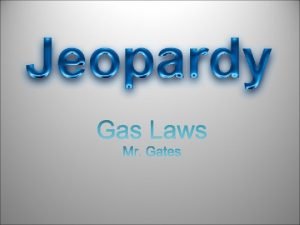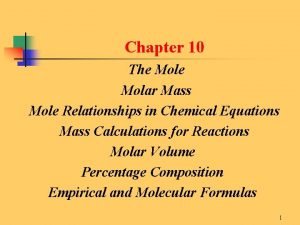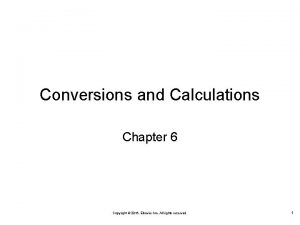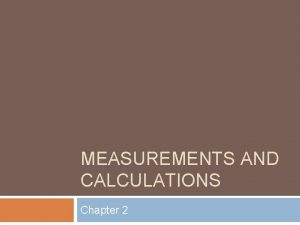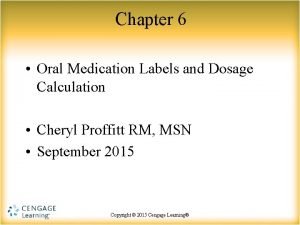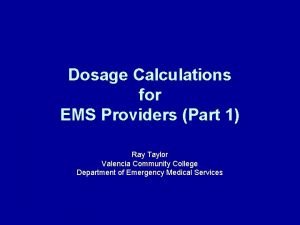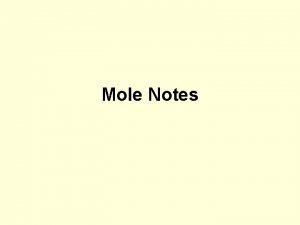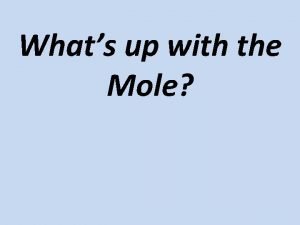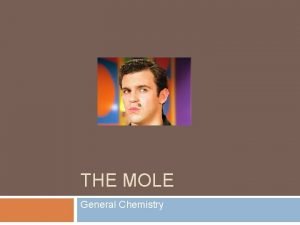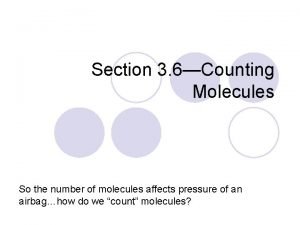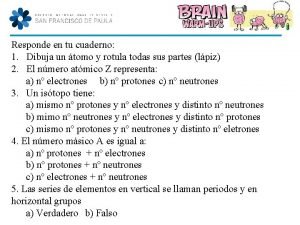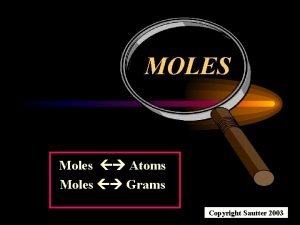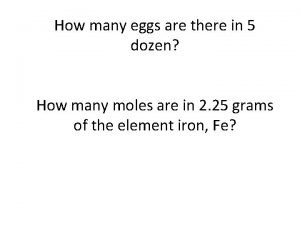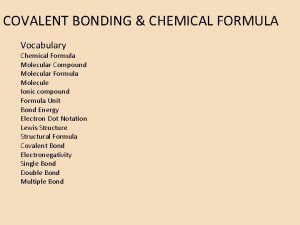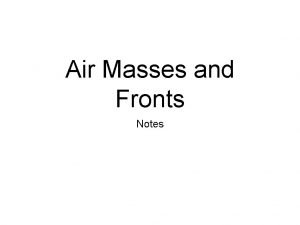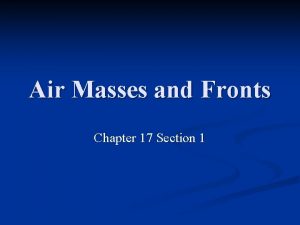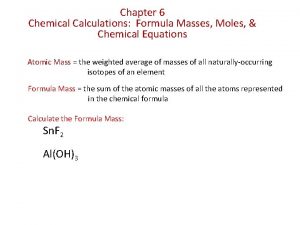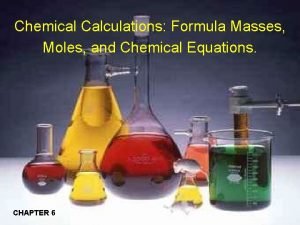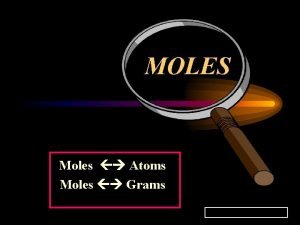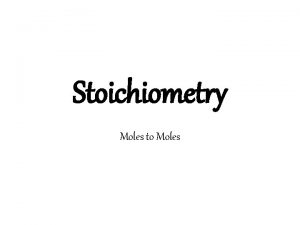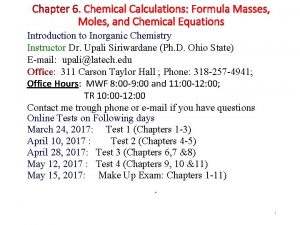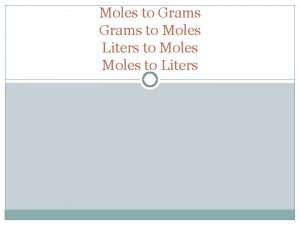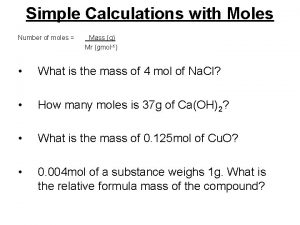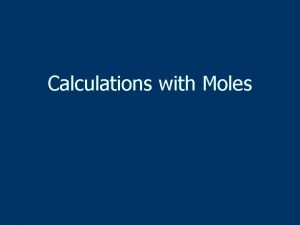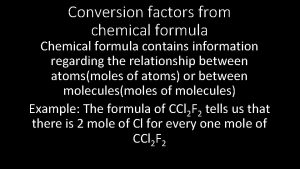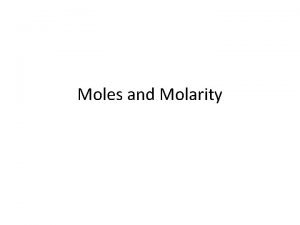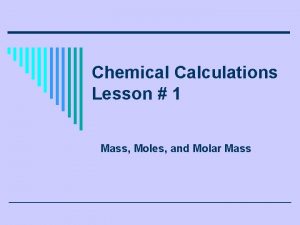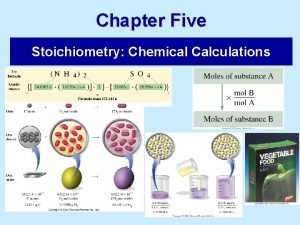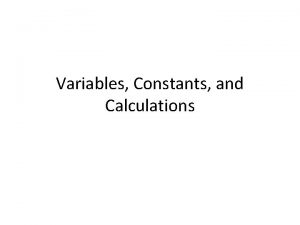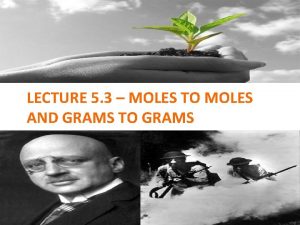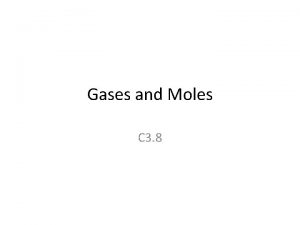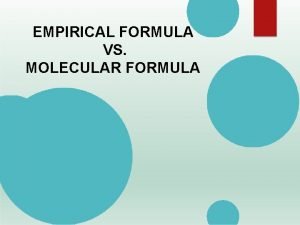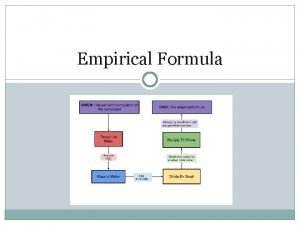Chapter 6 Chemical calculations formula masses moles and



































- Slides: 35

Chapter 6 Chemical calculations, formula masses, moles, and chemical equations

Formula masses • The sum of the atomic masses of all of the atoms represented in the chemical formula of a substance is the formula mass. • Example: for H 2 O Formula mass = 18. 02 amu

Formula masses • The elemental masses that are used to determine the formula mass are found in the periodic table. • Another example: glucose, C 6 H 12 O 6 Formula mass = 180. 18 amu

The mole: a counting unit for chemists • The quantity of material in a sample can be counted in units of mass or units of amount. • Example: Counting by mass – 15 pounds of nails – 70 dozen nails Counting by amount

The mole: a counting unit for chemists • Masses need to be specified with their associated units. Otherwise, the quantity is meaningless. • Example: Mr. Powers, you’ve got eight to get out of the building before it explodes… Would be nice to know if this is eight seconds or minutes.

The mole: a counting unit for chemists • Since atoms are so small, we routinely deal with enormous numbers of them in our everyday experiences. – A spoon of sugar for your coffee has around 3 x 1021 sugar molecules in it. – A cup of water is about 8 x 1024 water molecules. • It is convenient to count things by amounts in chemistry, and the quantity used is the mole.

The mole: a counting unit for chemists Avogadro’s number • One mole is 6. 02 x 1023 objects. This quantity should be treated in the same way that other amount figures are used (e. g. a dozen objects is twelve objects). • A dozen eggs would be 12 eggs. Half a dozen eggs would be 6 eggs. • A mole of eggs would be 6. 02 x 1023 eggs. Half a mole of eggs would be 3. 01 x 1023 eggs. • Conversion factors that will often be used are

The mole: a counting unit for chemists • Using dimensional analysis, it is easy to determine the number of molecules, atoms, etc. that are present in some sample. • Example: how many molecules of water are in 0. 25 moles of water? How many hydrogen atoms are in 0. 25 moles of water? This conversion factor is based on the fact that there are two H atoms in each H 2 O molecule

Mass of a mole • The mass of a mole of some chemical substance is the numerically the same as the substance’s formula mass. Instead of units of amu, the mole has mass units of grams. – The mass of a molecule of H 2 O is 18. 02 amu – The mass of a mole of H 2 O is 18. 02 g This quantity is called the “molar mass’ of water

Mass of a mole • A molar mass itself is a conversion factor: 1 mole H 2 O = 18. 02 g H 2 O • Converting between grams and moles is straightforward using dimensional analysis. • How much does 4. 0 moles of water weigh? Desired unit Given unit

Mass of a mole • Avogadro’s number (6. 02 x 1023) is the number of atoms of 12 C in an isotopically pure sample of 12 C that weighs exactly 12 g.

The mole and chemical calculations As we saw a few slides ago, it is possible to use a chemical formula to create a conversion factor that allows us to determine the number of atoms of some element is a sample. We also know that 1 mole means Avogadro’s number of objects (molecules, atoms, etc. ) e. g. 1) How many C 6 H 12 O 6 molecules are in 1. 0 g of C 6 H 12 O 6? 2) How many H atoms are in 1. 0 g of C 6 H 12 O 6?

The mole and chemical calculations • 1)Work out the molar mass for C 6 H 12 O 6 first: Then use known conversion factors to change g C 6 H 12 O 6 to molecules of C 6 H 12 O 6 = 3. 3 x 1021 C 6 H 12 O 6 molecules Avogadro’s number: 1 mole = 6. 02 x 1023 objects

The mole and chemical calculations • 2) From the formula (C 6 H 12 O 6) you can see that there are 12 H atoms in each C 6 H 12 O 6 molecule. Make another conversion factor to change molecules C 6 H 12 O 6 to atoms of H: = 4. 0 x 1022 H atoms

The mole and chemical calculations • This can be done all at once, too: = 4. 0 x 1022 H atoms

Writing and balancing chemical equations • A chemical equation is a statement that expresses what changes occur in a chemical reaction (i. e. what is reacting and what is created) beginning of reaction end of reaction

Writing and balancing chemical equations CH 4 (g) + 2 O 2 (g) Reactants appear on the left side of the equation. CO 2 (g) + 2 H 2 O (g)

Writing and balancing chemical equations CH 4 (g) + 2 O 2 (g) Products appear on the right side of the equation. CO 2 (g) + 2 H 2 O (g)

Writing and balancing chemical equations CH 4 (g) + 2 O 2 (g) CO 2 (g) + 2 H 2 O (g) The states of the reactants and products are written in parentheses to the right of each compound. (s) = solid (l) = liquid (g) = gas (aq) = aqueous solution

Writing and balancing chemical equations CH 4 (g) + 2 O 2 (g) CO 2 (g) + 2 H 2 O (g) In this reaction, the reactants and products are said to be “balanced” – there are equal numbers of atoms of each element on the reactant and product sides of the equation. A balanced equation contains the lowest possible whole number coefficients

Writing and balancing chemical equations CH 4 (g) + 2 O 2 (g) Coefficients are inserted to balance the equation. CO 2 (g) + 2 H 2 O (g)

Subscripts and Coefficients Give Different Information • Subscripts tell the number of atoms of each element in a molecule

Subscripts and Coefficients Give Different Information • Subscripts tell the number of atoms of each element in a molecule • Coefficients tell the number of molecules

Writing and balancing chemical equations • One of the fundamental laws of nature is that matter and energy can’t be created or destroyed. In chemical equations, this is reflected in the need for equations to be balanced. • There must be equal numbers of atoms of each element on both sides of the equation. 4 NH 3 +3 O 2 2 N 2 +6 H 2 O

Writing and balancing chemical equations • Balancing a chemical equation is probably best accomplished by starting with an element that occurs in only one formula on each side of the equation: C 3 H 6 O + O 2 CO 2 + H 2 O Could start with carbon (C) or (H). I’ll start with C. There are 3 C atoms on the reactant side and only one on the product side. Write a coefficient of “ 3” in front of CO 2 to balance the carbon atoms in the equation

Writing and balancing chemical equations • Balancing a chemical equation is probably best accomplished by starting with an element that occurs in only one formula on each side of the equation: C 3 H 6 O + O 2 3 CO 2 + H 2 O Hydrogen occurs in only one formula on each side. Let’s balance H next by putting a “ 3” in front of H 2 O.

Writing and balancing chemical equations • Balancing a chemical equation is probably best accomplished by starting with an element that occurs in only one formula on each side of the equation: C 3 H 6 O + O 2 3 CO 2 +3 H 2 O Now, C and H are balanced in the above equation. Can see that there are unequal numbers of O atoms on each side (3 and 9). By putting a “ 4” in front of O 2, we balance the equation.

Writing and balancing chemical equations • Balancing a chemical equation is probably best accomplished by starting with an element that occurs in only one formula on each side of the equation: C 3 H 6 O +4 O 2 3 CO 2 +3 H 2 O Check: reactants products C: 3 3 H: 6 6 O: 9 9

Chemical equations and the mole concept • The coefficients in a balanced chemical equation tell us the molar ratios that exist between the substances consumed on the reactant side and the substances made (the product side) CH 4 (g) + 2 O 2 (g) CO 2 (g) + 2 H 2 O (g)

Chemical equations and the mole concept • The following equation gives us these conversion factors: – Two H 2 molecules are needed in this reaction with O 2 to produce two H 2 O molecules – Two moles of H 2 are needed in this reaction with O 2 to produce two moles of H 2 O

Chemical equations and the mole concept • The following equation gives us these conversion factors: Between H 2 and H 2 O Between H 2 and O 2 Between O 2 and H 2 O

Chemical calculations using chemical equations • Using the molar relationship between a substance in a balanced chemical equation and some other reactant or product, you can determine the moles (or mass) of product that can be made starting with a certain mass (or number of moles) of reactant. C 6 H 12 O 6 + 6 O 2 6 CO 2 + 6 H 2 O How many grams of water will the body produce via this reaction if a person consumes a candy bar containing 14. 2 g of glucose? Consider the molar relationship between C 6 H 12 O 6 and H 2 O. For every mole of C 6 H 12 O 6 consumed, 6 moles of H 2 O will be produced.

Chemical calculations using chemical equations • We’ll need to: – Convert 14. 2 g of C 6 H 12 O 6 using the molar mass for glucose (180. 18 g = 1 mole) – Use the molar relationship that exists between C 6 H 12 O 6 and H 2 O to convert moles of C 6 H 12 O 6 to moles of H 2 O – Use the molar mass for H 2 O (18. 02 g = 1 mole) Molar mass of C 6 H 12 O 6 Molar mass of H 2 O Molar ratio between C 6 H 12 O 6 and H 2 O

Chemical calculations using chemical equations • There a number of questions that may be asked in these types of problems: – How much of a product is made from a certain amount of a reactant? – How much of a second reactant is consumed when a given amount of the other reactant is involved? – How many molecules of a product are created, given a certain mass of reactant used? – How many grams of an element are present in a certain amount of product? C 6 H 12 O 6 + 6 O 2 6 CO 2 + 6 H 2 O If 14. 2 g of C 6 H 12 O 6 are reacted, how many grams of O are present in the water that is produced? Molar mass C 6 H 12 O 6 14. 2 g C 6 H 12 O 6 mol H 2 O Molar mass O mol O (in H 2 O) g O in H 2 O

Chemical calculations using chemical equations C 6 H 12 O 6 + 6 O 2 6 CO 2 + 6 H 2 O If 14. 2 g of C 6 H 12 O 6 are reacted, how many grams of O are present in the water that is produced? Molar mass C 6 H 12 O 6 14. 2 g C 6 H 12 O 6 mol H 2 O Molar mass O mol O (in H 2 O) g O in H 2 O =7. 57 g of O
 Ideal gas law powerpoint
Ideal gas law powerpoint Types of connections in steel structures
Types of connections in steel structures Chemical formula
Chemical formula Chapter 7 chemical formulas and chemical compounds test
Chapter 7 chemical formulas and chemical compounds test Trinitrogen monosulfide formula
Trinitrogen monosulfide formula The calculations of quantities in chemical reactions
The calculations of quantities in chemical reactions Chapter 18 chemical reactions balancing chemical equations
Chapter 18 chemical reactions balancing chemical equations Cl- molar mass
Cl- molar mass Chapter 2 measurements and calculations
Chapter 2 measurements and calculations Conversions and calculations chapter 6
Conversions and calculations chapter 6 Measurements and calculations chapter 2 test
Measurements and calculations chapter 2 test Dosage calculations formula
Dosage calculations formula Dosage on hand formula
Dosage on hand formula Pediatric dosage calculations for nurses
Pediatric dosage calculations for nurses Dosage on hand formula
Dosage on hand formula Formula to find number of moles
Formula to find number of moles 16:00
16:00 Formula units to moles
Formula units to moles The mole road map
The mole road map Grams to mole
Grams to mole Mole conversion chart
Mole conversion chart Formula de los moles
Formula de los moles Grams to mole
Grams to mole Grams to mass formula
Grams to mass formula Moles to molecules
Moles to molecules Grams to moles formula
Grams to moles formula 5 dozen of 50 grams
5 dozen of 50 grams The chemical formula of a compound indicates
The chemical formula of a compound indicates What is the difference between molecule and compound
What is the difference between molecule and compound Chemical names and formulas chapter 9
Chemical names and formulas chapter 9 Two astronauts of masses 60 kg and 80 kg
Two astronauts of masses 60 kg and 80 kg Air masses and their characteristics
Air masses and their characteristics Area of low pressure where air masses meet and rise
Area of low pressure where air masses meet and rise What are middle-latitude cyclones?
What are middle-latitude cyclones? Types of fronts
Types of fronts Air masses form in the tropics and have low pressure
Air masses form in the tropics and have low pressure
